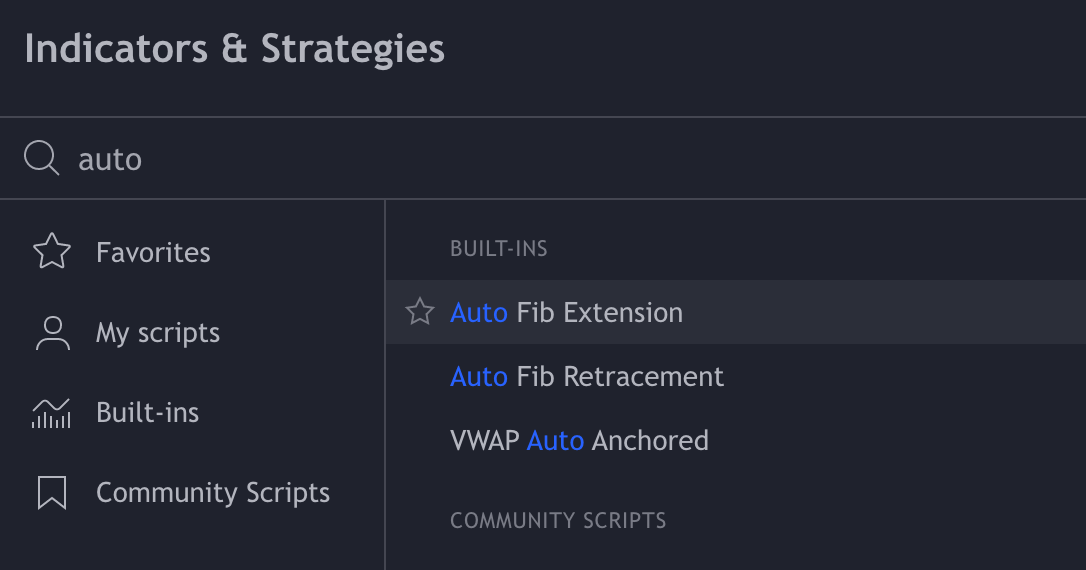VPVR is short for Volume Profile Visible Range, a popular volume trading tool. VPVR paints a histogram of traded volume at each price level for as much of the past price action as you can see in your current chart window.
There is a lot of content on volume trading in crypto on AltcoinTrading.NET.
- Glossary entry on basics of volume trading
- ScriptSpotlight for free volume profile scripts on TradingView
I am going to repeat some of the information from those here, to save you a click. If you are already familiar with volume profiles, just skip to the sections that interest you.
In this trading strategy:
- Where to trade VPVR: Charting platforms that give free versions of VPVR
- Cryptowatch for visible range profile
- TradingView for fixed range profile
- How to read VPVR indicator
- Best manual volume profile trading strategies:
- How to automate volume trading and volume profile trading
Platforms for VPVR trading
VPVR, Volume Profile Visible Range, used to be a strictly premium technical indicator. Since 2021 you can get a very good equivalent of VPVR for free on Cryptowatch.
Cryptowatch is also the only charting app where you can directly on VPVR from the same chart. You just need to import your exchange keys into Cryptowatch.
Here’s how to find the VPVR on there:
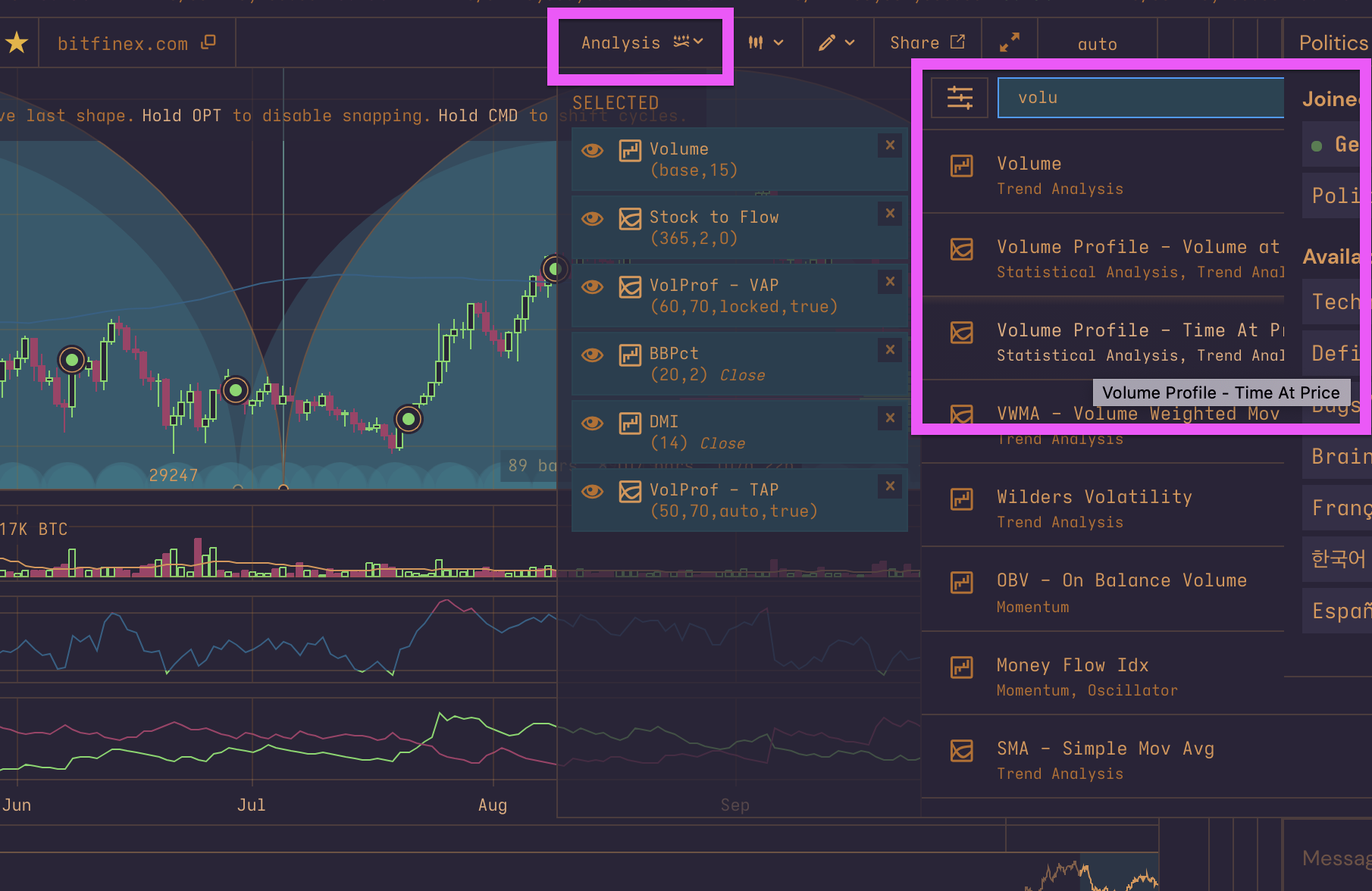
If you don’t want to use Cryptowatch, TradingView has a bunch of good volume profile alternatives. They are all fixed range, but those may be actually easier to trade on. If you trade on 3H chart or shorter, you will make a good use of daily fixed range volume profile (that is, one volume profile for one trading day).
Here’s a link to a good free volume profile daily fixed range on TradingView:
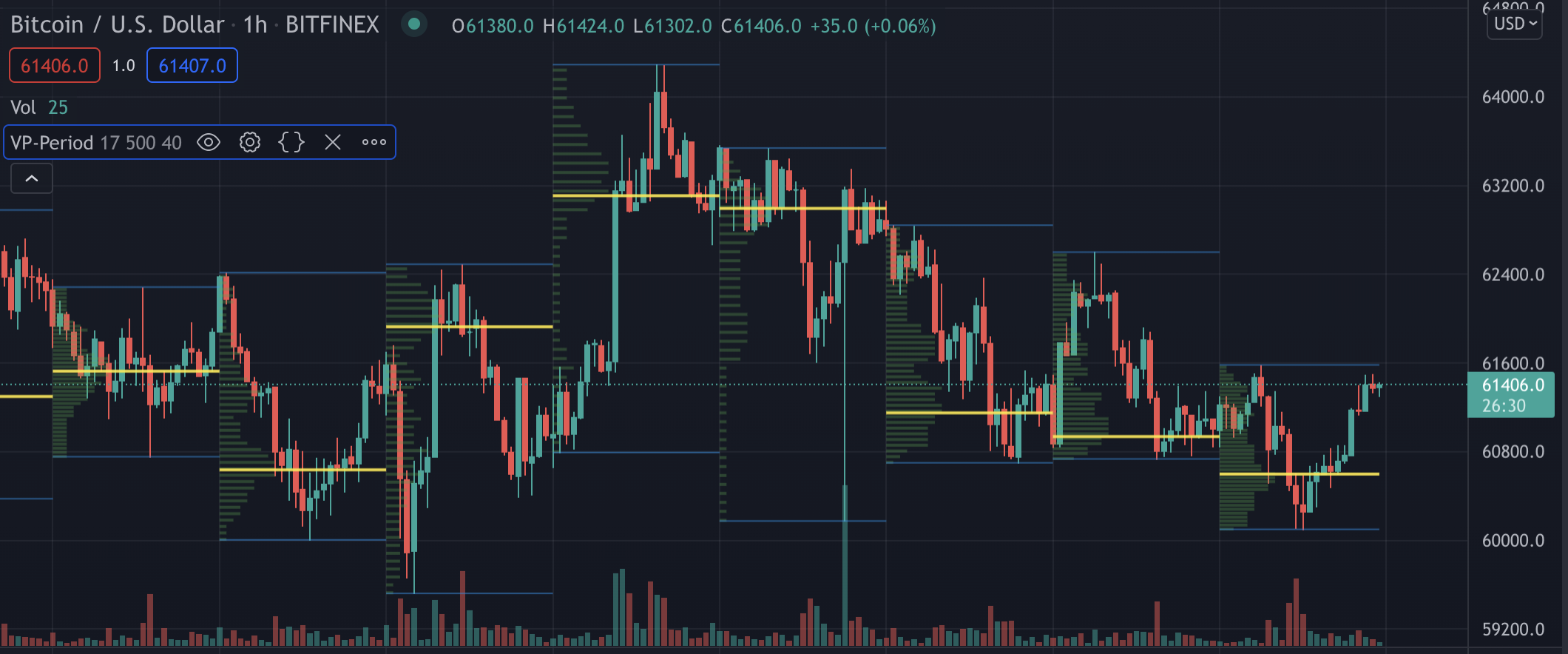
How to read volume profile
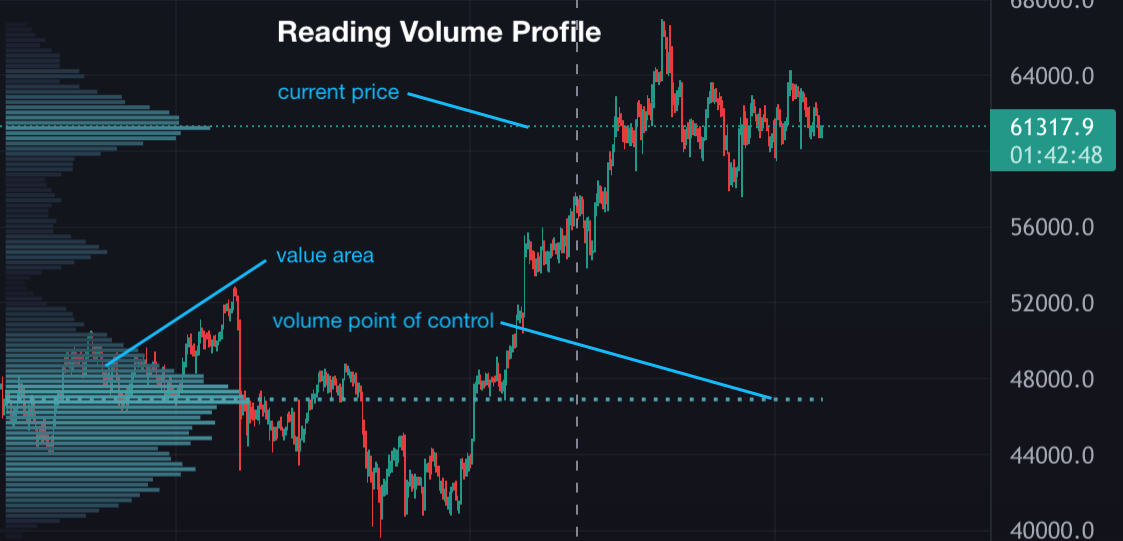
From our glossary:
Reading VPVR boils down to two three things:
-
Find the price with the highest traded volume.
This brings you close to identifying areas of supply and demand, and therefore your support and resistance. The VPVR histogram will get highlighted through this part - the value area.
The highest volume price level is called the volume point of control, or VPOC.
-
Find the gaps.
The “filling of the gap” is infamous, especially in crypto.
Still, if price didn’t stay somewhere for very long, than that area might have been covered in an irrational speculative run.
-
Make sure you are not looking at bogus data.
Both fixed range and visible range volume profile lets you roll back through the market history. This is especially bad if you want to trade on volume profile patterns: They are dangerous as depending on where you stop, you will get varying degrees of bullshit.
Visible range volume profiles are a much safer tool for traders who actually watch the charts during the day. This way the trader knows how the volume profile developed, and possibly made some notes about it into the chart.
If you don’t want to watch the charts all day, use a fixed range volume profile, but stick to a specific range. The best range to choose is daily - here’s once again the daily volume profile script from TradingView.
As a note, daily volume profile also can be used as a simplified tool for market profile analysis.
Best Manual Volume Profile Fixed Range Trading Strategies

Fix range volume profile trading is good for day traders. It will also work for anyone who speculates short-term on alt coin markets but does not want to get stuck holding the alt coin.
Using fixed range volume profile, you can best make the use of the regularities in daily trading activity.
Set your range to daily (like with this free one on TradingView shown on the picture above) and trade on the comparison between today’s prices vs yesterday’s high volume prices.
Comparing today’s and yesterday’s price action compares how the mood on the market changed between the two days.
• No intricate patterns are needed to trade on fix range volume, you are simply comparing today’s value area with the previous day’s value area.
• You may use other technical indicators for your entry: MACD, EMA or ALMA, RSI and its transformations, support and resistance.
• This is short-term trading, so set your stop losses and and close rather too early than too late.
As a technical note, you will need to trade on the 1H chart or shorter: Considering these are daily volume profiles, you won’t even get to see much on anything over 3H or 4H.
Fixed Volume Profile, 1D Range, Bullish Strategy
The day is setting up for a bullish opportunity if the daily trading starts off above the previous day’s value area, but ideally not fully above the full profile.
This shows that there is a lot of demand driving the price up, but it’s not a full on FOMO.
There will most likely be an attack at a new high. The strategy is to wait for a retracement from that and buy there.
Here’s what it looks like. This is from LUNAUSD, 1H:
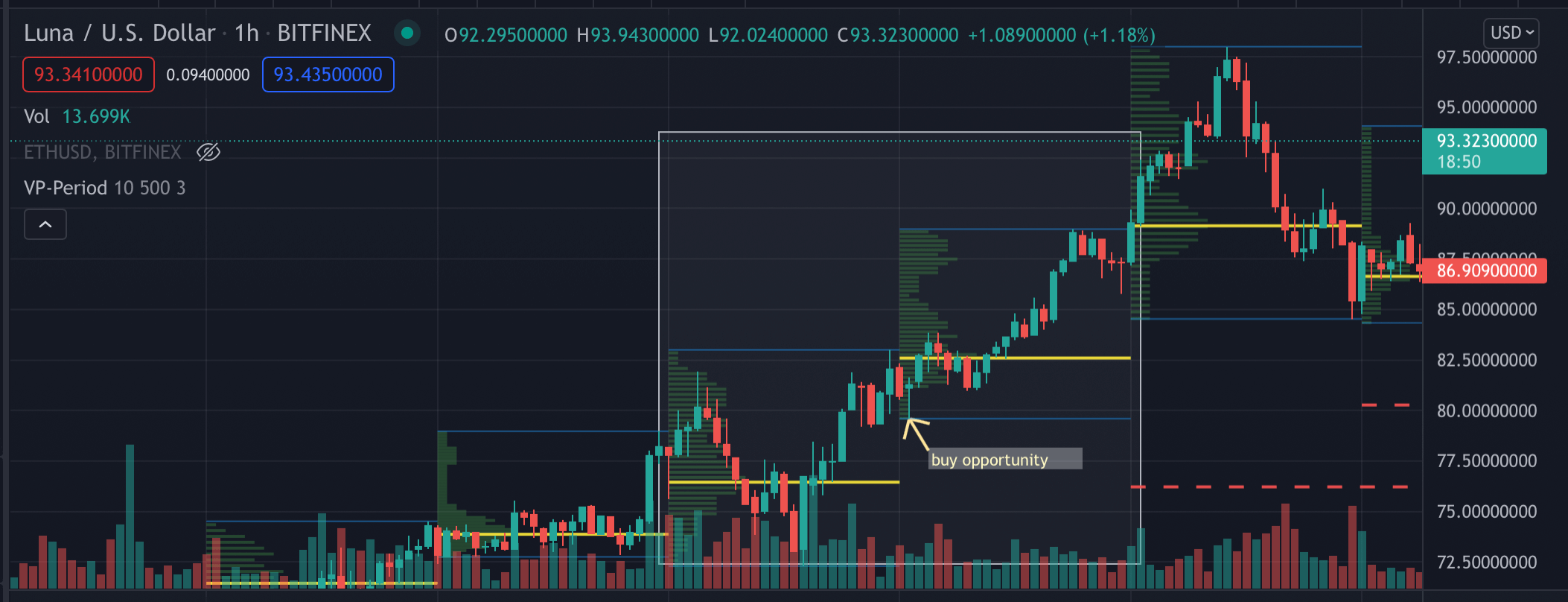
You probably know that retracements and flags usually have two bottoms, but thanks to your volume profile you also know the market is showing strength, so it is better to not wait for the second one as it might not actually paint.
• Yesterday’s value area is your stop loss.
• Move your stop loss into breakeven and then into profit as soon as possible.
• You will want to get out on the next top, either by closing or by having your stop triggered.
Fixed Volume Profile, 1D Range, Bearish Strategy
Analogous to the bull case, the day is setting up for a bearish opportunity if the daily trading starts off below the previous day’s value area, but ideally not fully crashing.
If the price retraces upwards to the previous day’s value area, and is rejected, that is a short setup.
Again, use a stop loss - at the old resistance and shift it down. You might want to watch your favourite oscillating indicators to see if they reset (for instance, stoch RSI or iF RSI) or just take profit near the next support level.
Here’s what the setup looks like on LUNAUSD (1H):
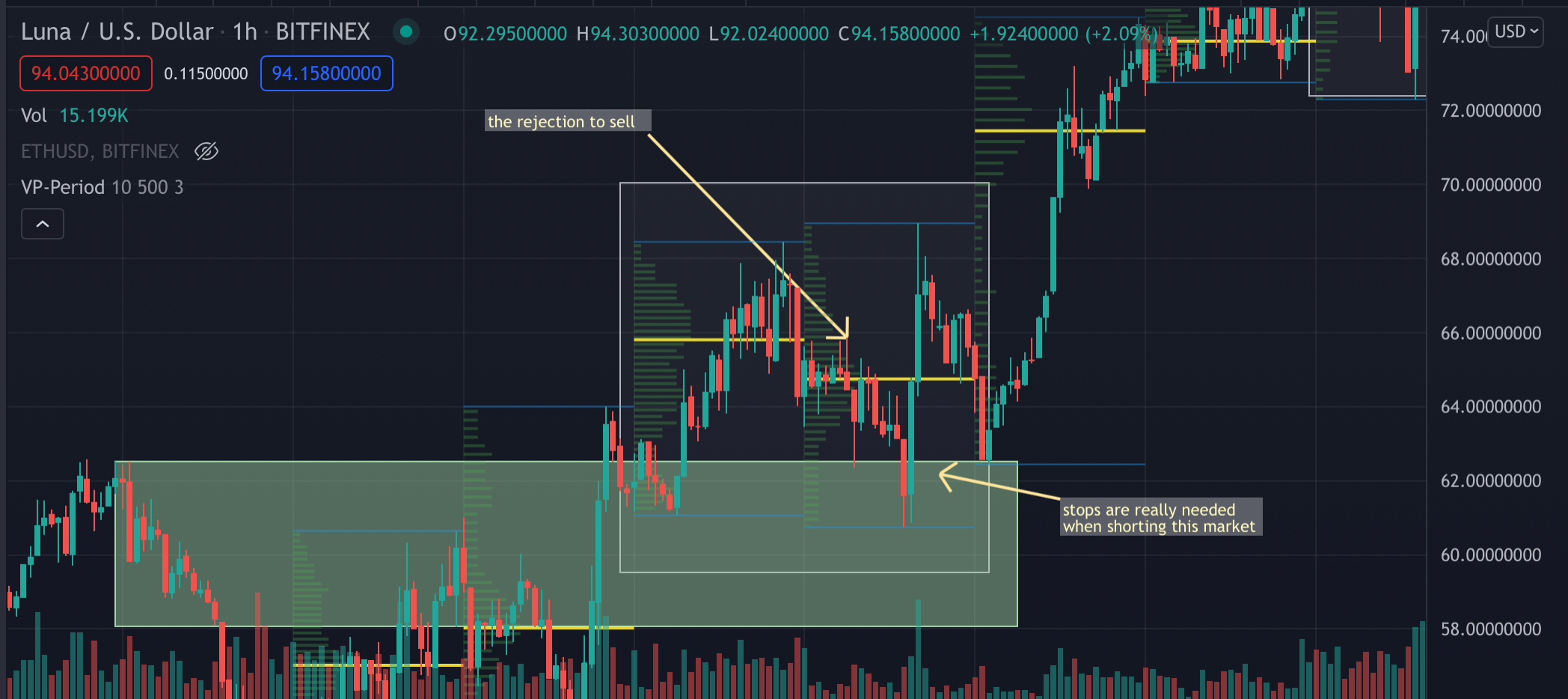
Always be mindful of the overall trend on the market, as you can see from the picture above.
On this snapshot, LUNA is firmly trending bullish. If you short it, you need to make sure you’ll be able to get out quick to keep your profits. Use a market stop.
Best Manual Volume Profile Visible Range Trading Strategies
Visible range volume profile histogram shows the traded volume per price level for as far back as the market goes in your chart window. This information is completely fluid, it accumulates over time, so it doesn’t make much sense to look for patterns within it.
VPVR is great for seeing support and resistance levels at the first glance. Because it accumulates, it will give you the high volume areas from previous flags and ranges too, as long as they are visible in your chart window.
You can use this information for scalping and for swing trading, because in both these styles you need to work with support and resistance levels.
- The support and resistance provided by VPVR is based on past data, and will always be good for your entries.
- Depending on where the market is trending, there may or may not not be enough information via VPVR to anticipate your exit.
- If the market is running above ATH, there’s no history to get resistance information from. In this case, use Fibonacci extension (there’s an AutoFib script on TradingView that paints them for you) and orderbook visualisation to see where people stack orders - Tensorcharts do that.
VPVR Indicator Support & Resistance Analysis
This is what suppport and resistance analysis with VPVR looks like on SOLUSD on FTX. Here is a 4H chart that uses only VPVR and stoch-RSI oscillator to get the “oversold” or “overbought” information.
You would use this sort of timeframe for swing trading, but if you are a scalper, the same workflow answers on 5-30M charts.
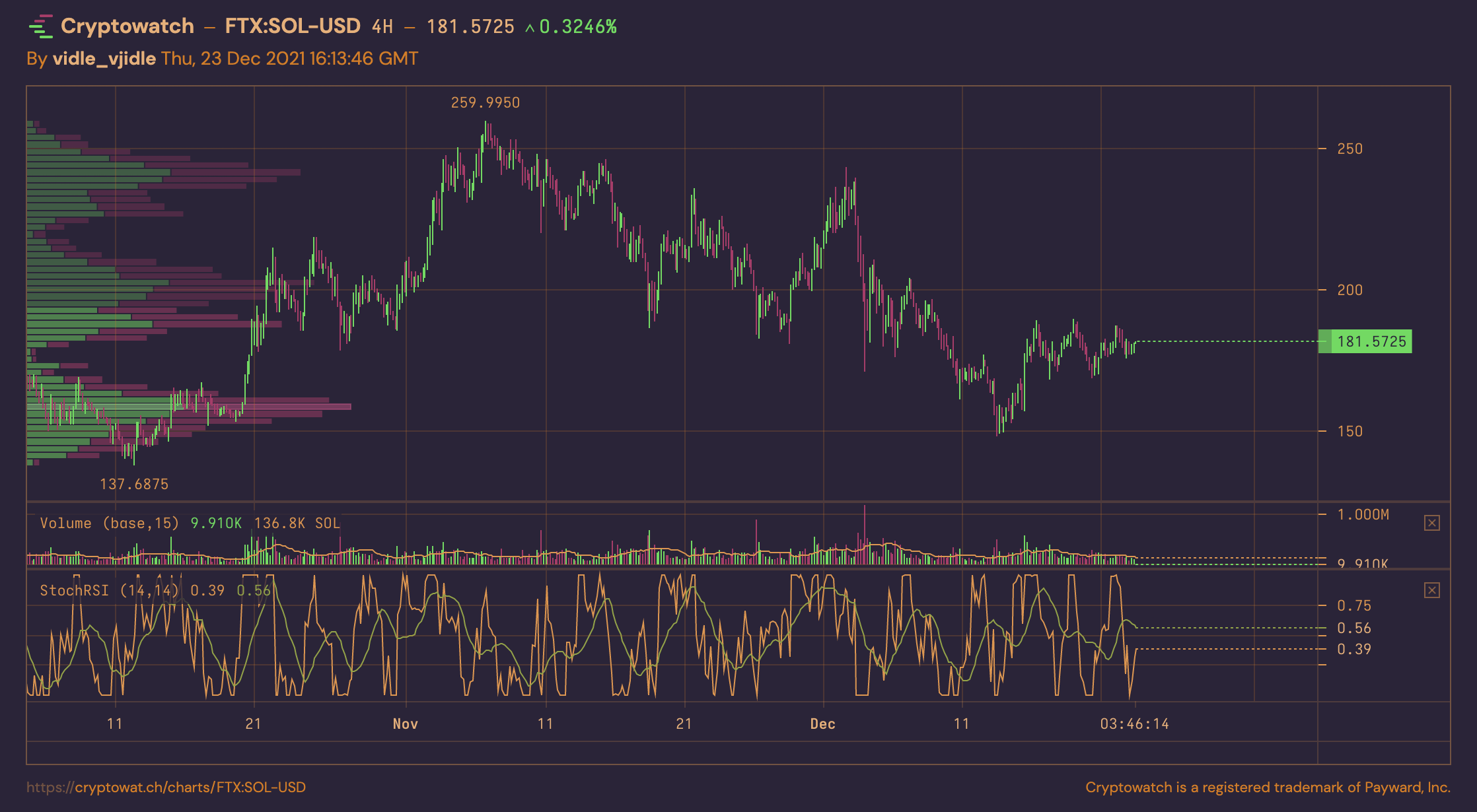
• There is a lot of support accumulated over the current range, and then further down from the long period around 20-50 USD (not shown here).
• 1D RSI shows the last rally only made a lower high and didn’t overcome the value area of the range, all the while making the RSI shoot up towards “overbought”: This is a sign of weakness and mid-term bearish.
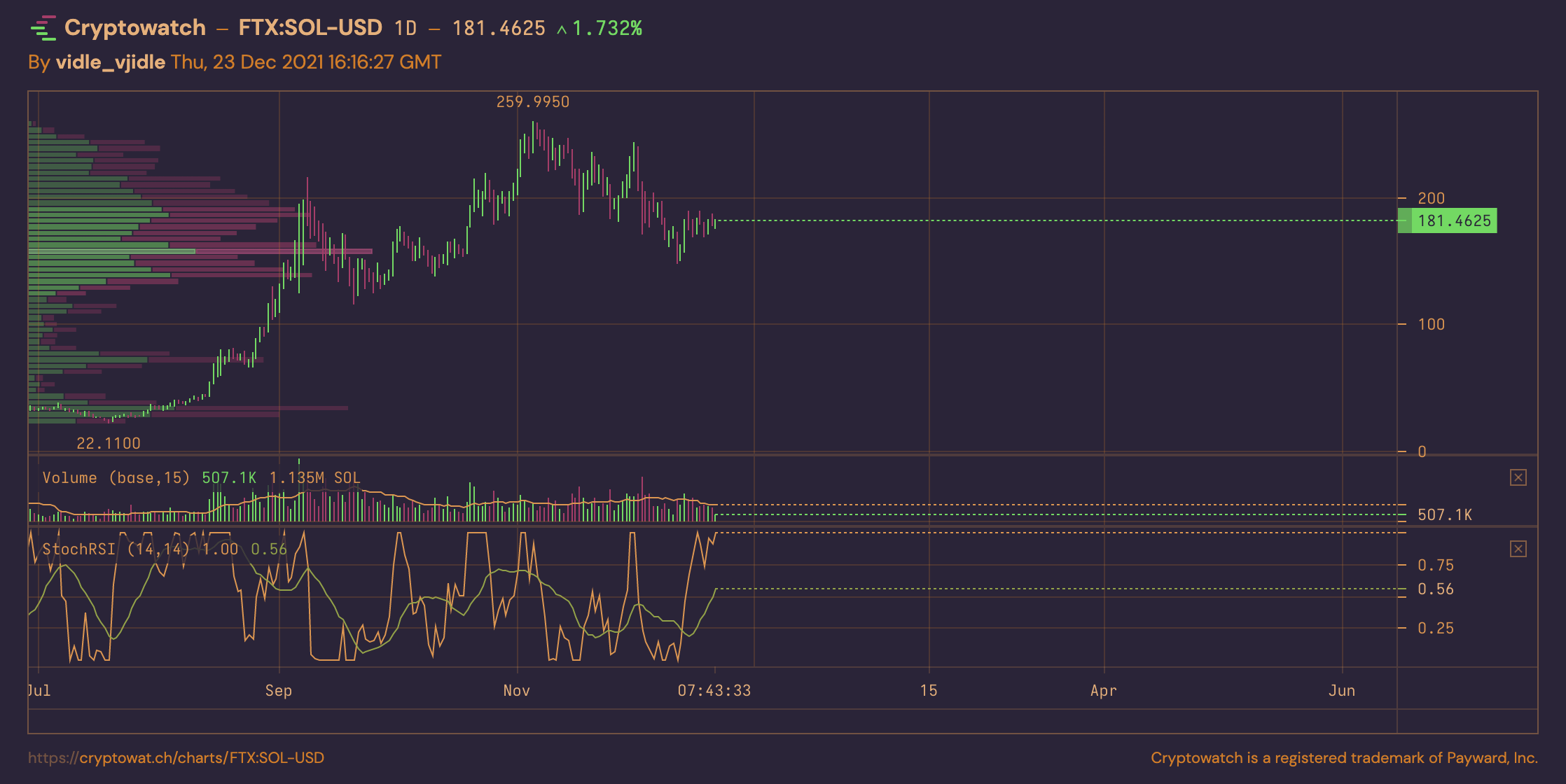
If you are looking for a speculation, in this scenario you will be better off moving on to some other alt coin - one that shows strength. You will be able to pull off speculative trades faster and with less stress there.
If you want to hold Solana on the other hand, this would be a time to give the market more attention.
• Trading on 1D, pay attention to fundamentals. Solana is tied with NFTs, so find out how the fundamentals there are looking currently: The chart being from December 2021, consider the ETH network upgrades in 2021. Will the hype around Solana’s slowly disappear? Or is there a case for accumulating?
• Set up alerts for the value area. If the market falls on good volume below the value area of the range, that’s bearish. You would use the Wyckoff method for ranges here.
How to automate volume profile trading
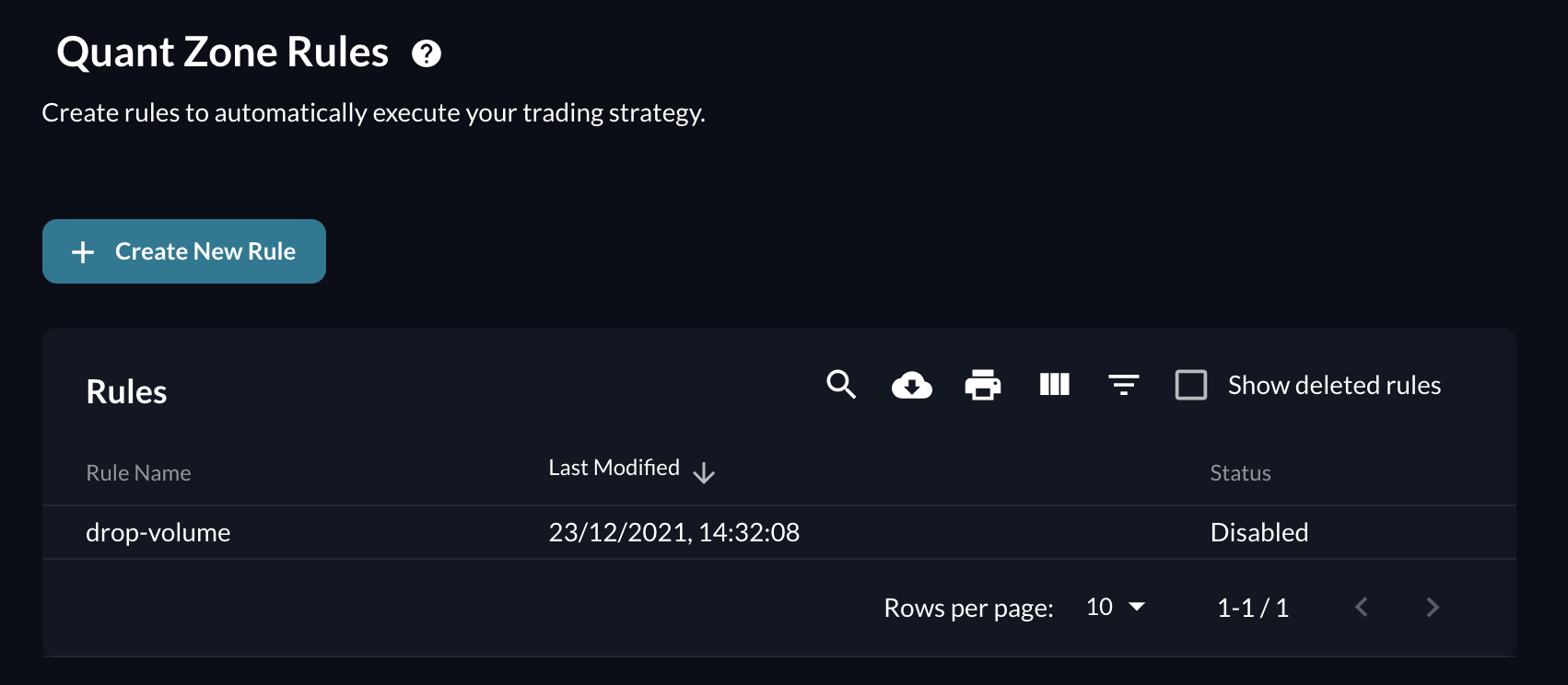
You will have a hard time automating trading with VPVR due to the fluid nature of the indicator.
If you want to automate your volume trading, you will be better off using either a fixed range volume profile, or sticking to the more standard volume tools like OBV (on-balance volume).
VPVR, or its cheaper equivalents, are good as long as you are willing to sit at the charts watching the volume indicator develop.
You can in theory automate the setups with a fixed range volume profile as described in this section. But so far, neither Shrimpy nor Coinrule auto-trading platform supports volume profiles.
You would have to implement a simplified version of a fix-range daily volume profile yourself. Here’s a list of reasonable simplifications:
- You only need to get the VPOC, not the full volume profile. The basic strategies just need the highest volume price over the whole trading day.
- Other than that you need the daily low and the daily high, which is a standard information in any daily OHLC data.
- The trigger is a rejection from the value area. Since you don’t have a value area, just the point-of-control, you would use statistics: Give it some percentage leeway.
- Don’t forget a trailing stop.
Automating simpler volume trading
Working with simpler volume tools is straightforward to automate, though.
A derisking example: Set up a rule at FTX Quant Zone to submit a sell order when price stays below a known resistance without breaching it, and at the same time daily traded volume rises over a certain value. This kind of scenario would possibly indicate that there is an increasing amount of selling and the market is about to top.
You the resistance could be an ATH, but it could also be an older value area - depends on what the market looks like.
Just note that this strategy is a better fit for larger cryptos that trade in ranges (BTC, ETH), not for newer alts that peak faster as traders bail on them easily.
Here is how to do a very basic setup in FTX Quant Zone (Refine it and DYOR, please!):
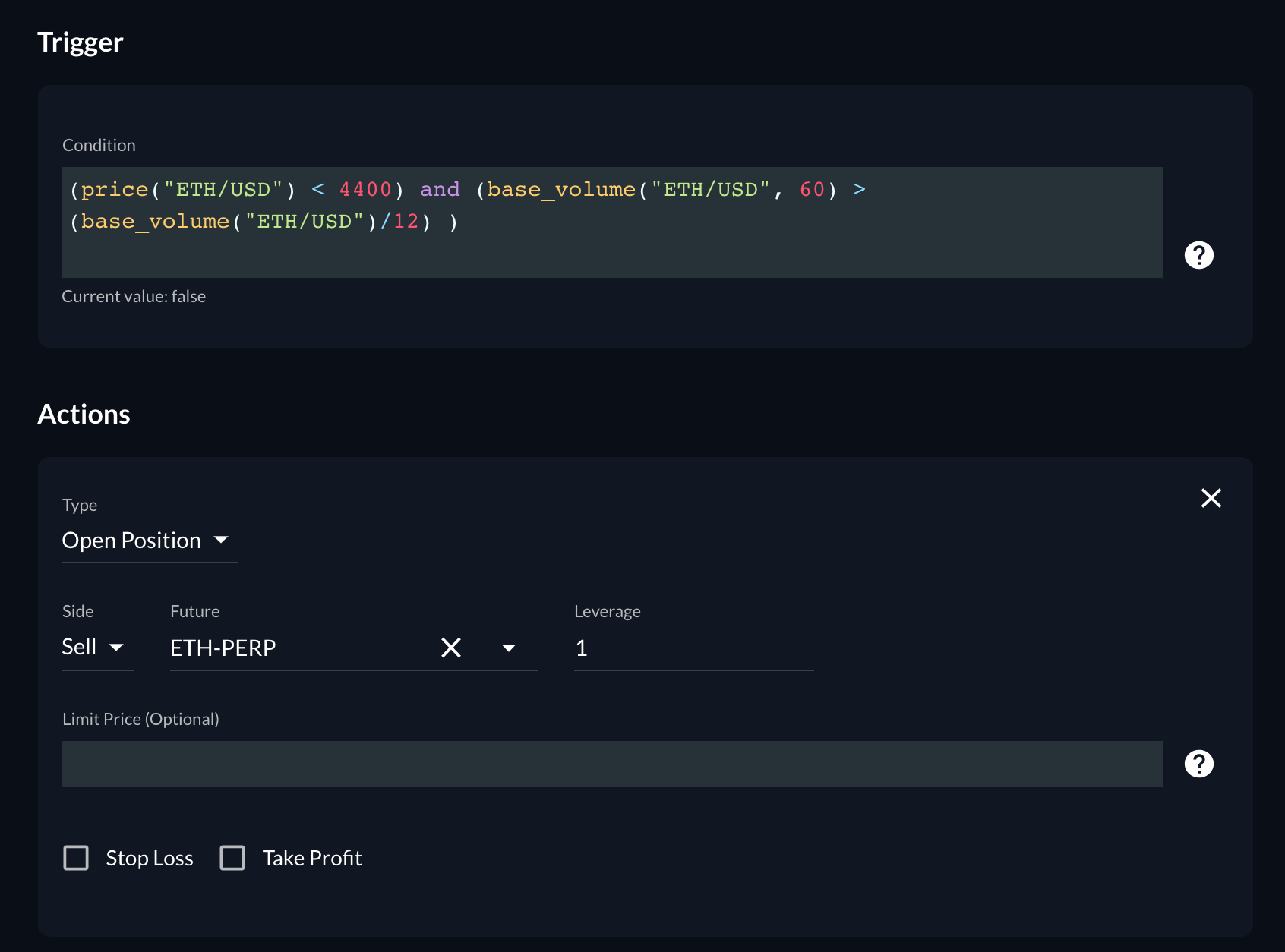
- Let’s suppose we are ranging up around ETH’s all time high area around $4790. You do not think that this is the top, but you do not want to hold ETH through a drawdown.
- So, let’s set up the condition for a price getting somewhat below the resistance. Refine this number by looking at the candle patterns around the top.
- Now let’s work out the volume requirement: Price needs to drop, but on volume. In this example, the second bracket requires volume in the last 60 minutes (
(base_volume("ETH/USD", 60)) to be higher than the average hourly volume over the past 24 hours ((base_volume("ETH/USD")/12)) - You can make the volume condition stronger or weaker:
> (base_volume("ETH/USD")/6)will let pass only volumes of more than double the average. - Set the action. In this example I set it to open an ETH perp short. This could be a hedge. Instead of that you could just deposit ETH and set it to be sold on spot though - that would make it a take-profit trade.
You will need to add further refinements to the condition to verify that the market is actually less and less likely to breach the resistance. Look around the FTX Quant zone, they have enough operators and some simple statistics built in.
Summary
By way of summary, here’s the list of tools and platforms mentioned in this article.

